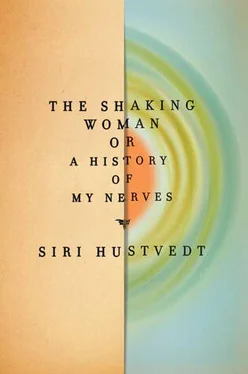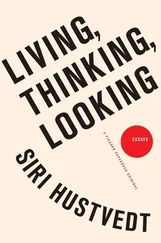Isn’t the neck the place where the head ends and the body begins? And isn’t the mind/body conundrum, ambiguous though it may be, the subject of this book, the same book I am writing now and was writing in the dream and would have to cut short? My father’s memoir was his last book. The number 3 hovers as the digit of gloom over the diagnosis — which summons Luria’s S., also a character in this text, Mr. Synesthesia, visual-memory man par excellence, a person whose last initial is the same as my first. The car is a vehicle of fear. I had written about cars during my day at the hospital. Later that evening, I sat directly behind a Buddhist monk who had been a leader in the May 2008 demonstrations against the Burmese government and a figure like him then appears in the front seat of my dream automobile. Along with everyone else in the audience at Cooper Union, I had watched a film clip of demonstrators running from gunfire and wounded people bleeding in the streets of Rangoon. I had read the passage assigned to me. Near the end of his text, Zargana writes, “And yet, there was nothing we could do…” In the dream the physician said, “There is nothing to be done.” My dream sadness looped back to D.’s sadness, to her cutting and to my cutting short the book — a sign perhaps of language cut short between me and my father, of last books, but also the voice, my voice in a lumpy diseased throat, and my father’s voice, now silent, and my making speeches and trying to speak while I’m shaking, which is my symptom, my limp or lameness, transformed into a terminal illness in the dream, like my father’s terminal illness, which was not in his leg but in his lungs and breath and which took his voice, a shaking, terrible silence — speechlessness. 128When I last spoke to him on the telephone, he could no longer speak. Identification as psychic wound. And finally, the dream returned to one of the poems by Theodore Roethke I had read with the adult patients at Payne Whitney. Entitled “Silence,” it ends with these lines:
If I should ever seek relief
From that monotony of grief,
The tight nerves leading to the throat
Would not release one riven note:
What shakes my skull to disrepair
Shall never touch another ear. 129
IN THE INTERPRETATION OF DREAMS, Freud writes, “I have already had occasion to point out that it is in fact never possible to be sure that a dream has been completely interpreted. Even if the solution seems satisfactory and without gaps the possibility remains that the dream may have yet another meaning.” 130Meaning is something we find and make. It is never complete. There are always holes. There is no consensus among scientists about why we sleep or why we dream. Nobody knows for sure. Sleep researchers agree that what Freud called Tagereste, translated as the “day residue,” shows up in our dreams. Many, not all, agree that dreams are often more emotional than waking life. It is known that the executive portions of the brain that inhibit our actions when we’re awake (the dorsolateral prefrontal cortex) are largely dormant when we sleep and dream. There has long been an idea among some scientists that sleep helps solidify memories, but others disagree. There is no consensus that dreams mean anything. Scientists are divided about exactly what parts of the brain are active and inactive; those who agree, often interpret the activity in different ways. In opposition to earlier orthodoxy, it is now known that there are REM dreams and non-REM dreams. The once direct association between rapid eye movement and dreaming no longer holds. A number of researchers have asserted that dreams are a kind of chaotic discharge, a churning nocturnal garbage dump that involves no higher-order functions, that dreams, by their very nature, cannot hold or reveal complex ideas. Among the most prominent dream researchers is Allan Hobson, a vigorous anti-Freudian, who proposed the activation-synthesis theory of dreaming. This theory maintains that the pontine brain stem, part of the old brain, in evolutionary terms, is critical to dreaming. According to Hobson and his colleague Robert McCarley, dreams have “no primary ideational, volitional, or emotional content.” 131Hobson has further insisted that dream plots have no coherent order and do not involve self-reflexive awareness. In one experiment, he took dream reports, cut them into pieces, and asked people to reassemble them in the correct order, something that turned out to be very hard to do. 132
But using my own dream as an example, I have to ask, Wouldn’t the doctor’s diagnosis of my cancer have to precede my pondering that same diagnosis in the car? Isn’t that a form of story logic? Didn’t my dreaming mind manufacture a narrative of my encounter with fatal news followed by my sadness about it? And although I didn’t know I was dreaming, doesn’t my dream self have a form of self-reflexive awareness? Didn’t that self meditate on last books and the end of life? And doesn’t the dream contain condensed ideas and primary emotional content? Am I a singular dreamer, someone without precedent in the history of the world? I doubt it. This is a case where a working theory leaves out the cases that run counter to it.
An article on the subject by Antti Revonsuo nods to Freud in its title, “The Reinterpretation of Dreams: An Evolutionary Hypothesis of the Function of Dreaming.” Unlike some researchers, Revonsuo cites the “overwhelming evidence” that dream content reflects the “emotional problems of the dreamer.” 133My dream appears to be a potent illustration of that truth. In order to make an evolutionary argument that dreaming is an older function of the brain, however, that our conflicted dreams are a kind of training ground of the mind to prepare us to face threats, he writes, “Therefore the principal reason we do not dream about writing, reading and doing arithmetic probably is that all these are cultural latecomers that have to be hammered into our cognitive architecture.” 134Following Revonsuo’s hypothesis, I am a more evolved creature than most other human beings because I dream about writing and reading all the time. As flattering as it might be to think of myself as further along on the evolutionary scale, this idea strikes me as dubious. Typing at my computer, reading books, finding letters and other texts, as well as hearing significant, often seemingly revelatory words have long played an important role in my dream life. Whatever one may think of my powers as a dream interpreter, my cancer dream served, among other things, as an answer to my having read Roethke’s “Silence” earlier that day. Until I reread the poem again after the dream, I had not noticed the striking relevance of the words for me personally: not just relief, grief, and throat but shakes. Without any acknowledgment from that fully awake teacher in the classroom, another part of me took in the poet’s language and respun it in the dream.
My daily writing and reading are often transmuted into a dream language or logic when I sleep. A friend of mine, R., a physicist who is now involved in neuroscience research on perception, related a dream to me while we were having lunch. I asked him to retell the story in an e-mail:
I had been working for days on a complicated calculation that required many pages of intricate algebra, with two central mathematical quantities that played a symmetrical role. I named them x and x prime. As a whole, the problem resisted me; whenever I had the feeling I was nearing a resolution, the calculation lashed back at me. One night, I dreamt of two twin brothers. Brash, unpleasant, aggressive, the two had come from some distant country. They were both human actors in the dream, but at the same time I knew they were x and x prime. I clearly remember my impression during the dream that these were the elements of my calculation and that they were manifestly antagonistic to my will. At first they behaved in a contained manner, then became more erratic. As far as I can remember, over the course of the dream, they progressively became less identified with x and x prime and more truly human.
Читать дальше












